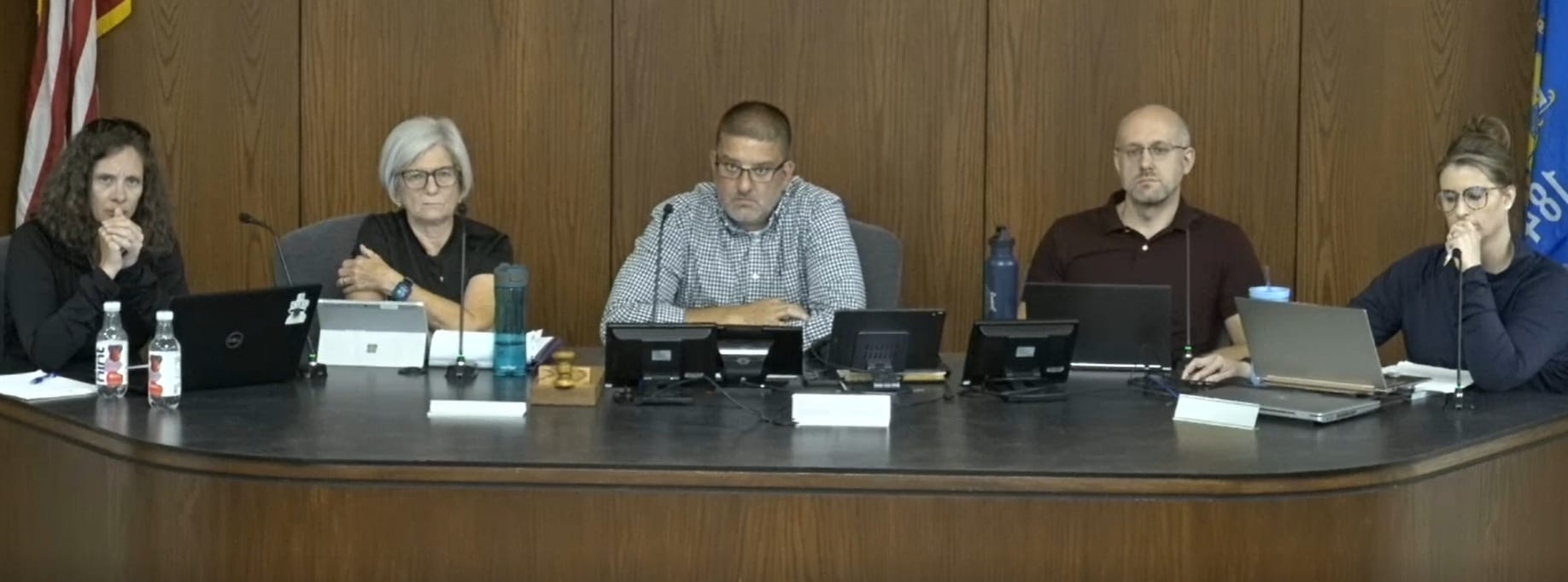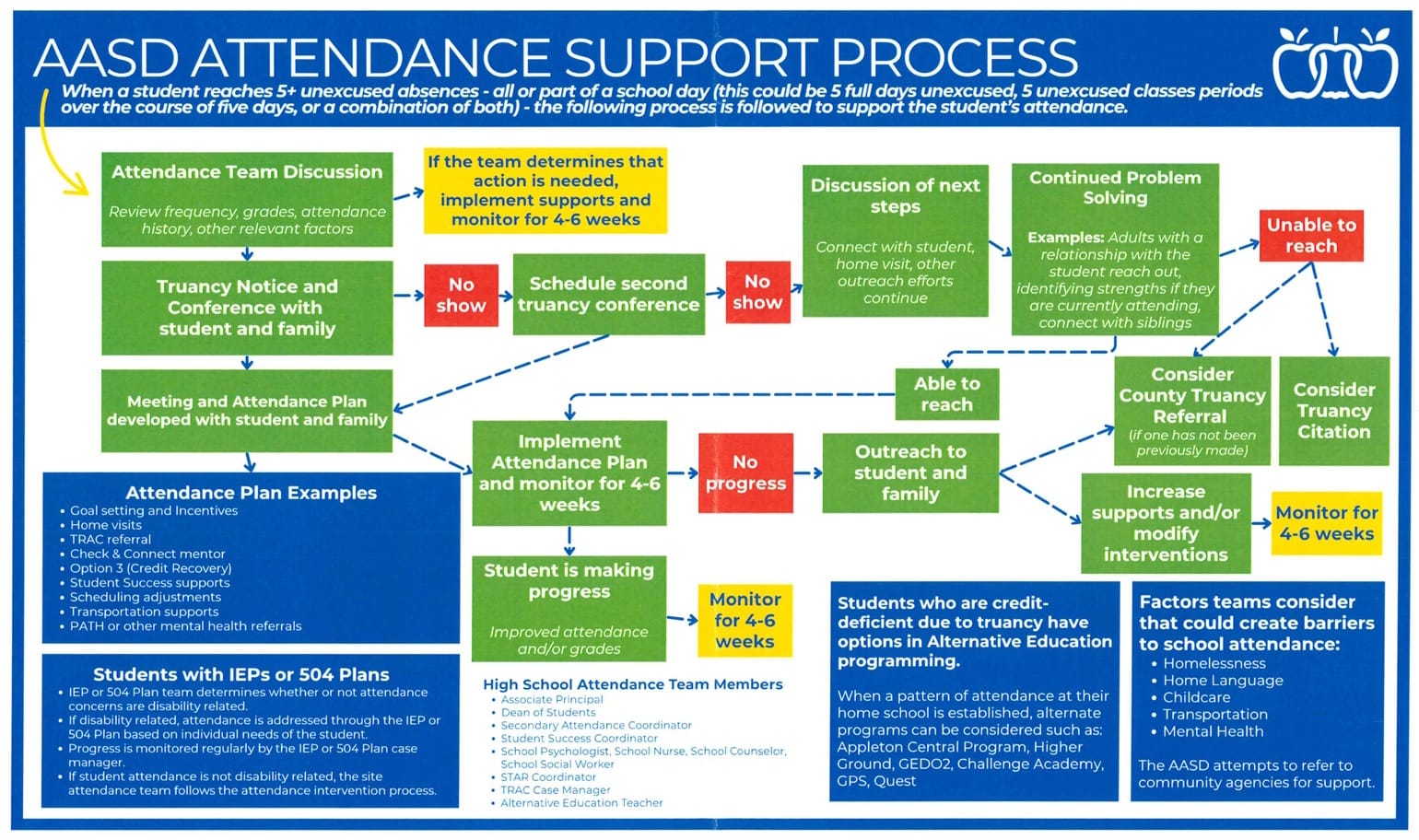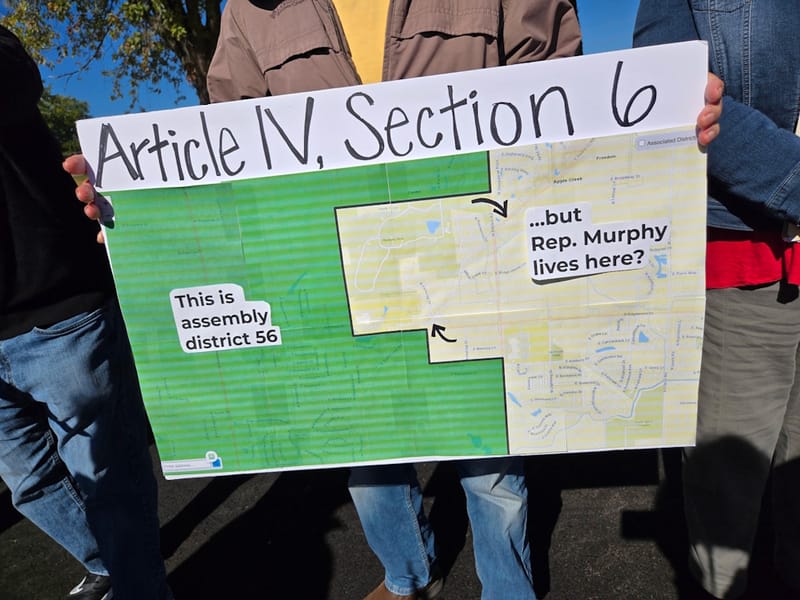The new Appleton truancy ordinance: How we got there
AASD reported chronic absenteeism rates of between 24 and 29 percent for high school students over the past three years. Despite using a three-tier attendance system school, administrators still could not connect with around 30 chronically absent students.

It took six months to resolve the contentious truancy issue – and that may just be temporary. Alder Denise Fenton, who also serves on the Safety and Licensing Committee where much of the negotiations occurred, takes us through the process.
By Denise Fenton
After months of meetings, listening sessions, back-and-forth proposals, one-on-one conversations, amendments and counter-amendments, the City of Appleton has a truancy ordinance once again, albeit one with several important guardrails.
The 9-6 vote by the Appleton Common council took place more than six months after the original resolution was introduced following a presentation on truancy by Superintendent Greg Hartjes of the Appleton Area School District. That proposal by outgoing Alder Bill Seibers prohibited a person under 18 from being habitually truant and included a four-semester trial period “after which time, a review of the success of the ordinance will be made by the City of Appleton, Outagamie County, and AASD with suggested, needed and agreed on changes being made.”
History of truancy ordinance and truancy court
AASD established the school-based truancy court in 2009, expanding it to the middle school level in 2013. Problems surfaced almost immediately, with a 2010 review denouncing the electronic monitoring of truant students who failed to follow court orders. A 2016 report found that the court ordered electronic monitoring twenty-seven times in the first half of 2016. The review also found that “several” students were placed in shelter care for between 20 and 60 days during that period.
AASD data confirmed that over a six-year span, 112 students – 16 percent of the total number of students in truancy court – were sent to shelter care. Four cases between 2011 and the end of the truancy court in 2019 were overturned by the Wisconsin Court of Appeals.
In 2018, such concerns led the district to hire an independent attorney, Duane McCrary of Madison, to conduct another review of the court. His report, submitted late that year, listed twelve recommendations for the truancy court, the first of which was the removal of Judge Mark McGinnis from truancy court responsibility. The last truancy citation was written on November 20, 2018, and the court was terminated in January. The Appleton Common Council voted 10-3 to repeal the city’s truancy ordinance in August 2019.
Chronic Absenteeism Exploded after Pandemic
While AASD put additional supports in place to improve attendance, the COVID pandemic changed everything. Nationwide, the number of students who were chronically absent – defined as missing 10% or more of school days – doubled. Chronic absenteeism increased across all demographics and in school districts of all sizes and income levels. Even districts that reopened quickly saw large increases. Appleton was no exception. AASD reported chronic absenteeism rates of between 24 and 29 percent for high school students over the past three years. Despite using a three-tier attendance system (see diagram below), school administrators still could not connect with around 30 chronically absent students.

The truancy resolution appeared on the agenda of the Common Council’s Safety and Licensing Committee on March 26 of this year, where the committee unanimously voted to hold it until the May 14 meeting to allow more time for input from the AASD and the community.
At that May meeting, Hartjes announced that Mayor Woodford had arranged a meeting of a group of stakeholders, including AASD Staff, City of Appleton staff, City of Appleton elected officials, Outagamie County Youth and Family Services staff, and Outagamie County Judge Carrie Schneider. I was disturbed that the committee was not informed about the identity of the elected officials at the meeting other than Mayor Woodford. We only found out in August that former Alder Siebers, Safety and Licensing Committee Chair Chris Croatt and Alder Sheri Hartzheim attended one or more of these meetings.
To me, this was a disturbing lack of transparency. The group met on April 15 and agreed to meet again to provide further information on the roles each would play if an attendance ordinance were to be adopted. Acting on Hartjes’s request, the committee held the item indefinitely.
Citizens air their concerns
In early August, AASD hosted what was billed as a community listening session, which began with a presentation on the issue. Attendees were then asked to move to small groups, each led by an AASD staff member, and to respond to specific questions. Most community members I spoke to after that session did not feel they were heard, complaining that there was little opportunity for input other than by answering pre-written questions.
As a result, these parents organized their own listening session two weeks later, where the speakers were close to unanimous in their lack of support for a reinstatement of a truancy ordinance.
On August 13, while no action was taken by the committee, the AASD administration for the first time provided the city a sense of what it had in mind for any truancy ordinance. After answering questions from Safety and Licensing Committee members for over an hour, district representatives presented a list of the dispositions, or penalties, from the state statute that they would and would not recommend that the city adopt.
(AASD) supported a fine of up to $250, possible suspension of a student’s driver’s license, orders to perform community service, attend counseling or an educational program, court supervision for up to a year, or revocations of work permits as supported dispositions.
They did not support orders for parents to attend counseling, stay-at-home orders or curfews, or orders for students to report to a youth report center during times they were not supervised by an adult.
They re-emphasized their plan to use a truancy citation as a last resort only for the approximately thirty students who had not responded to any attempts to get them back in school. They presented a checklist which would document all the attempts to contact an absent student and all of the interventions offered along with the results of those interventions. This information, Hartjes said, would be turned over to the School Resource Officer who would determine whether to issue a citation.
Committee negotiates details
On September 10, the Safety and Licensing Committee finally discussed the truancy resolution with the possibility of a vote. Alder Hartzheim quickly submitted a substitute resolution which called for adopting a truancy ordinance that conformed to the much stricter state statute and called on AASD to provide evidence of the measures taken to address a student’s attendance problem before any court dispositions were levied.
Hartzheim’s version, with its inclusion of some of the harshest dispositions in the state statute – despite AASD’s assertions that it did not support those punishments – was impossible for me to support.
Alder Firkus quickly moved to delete the more severe penalties contained in Hartzheim’s proposal that the AASD had earlier refused to support and to strengthen the reporting expectations for the district.
The meeting having run well past the start time for the next committee’s meeting, the members voted to hold the discussion until the September 24 meeting.
Hartjes spoke to the committee at that meeting and addressed concerns with some of the reporting requested in Firkus’s amendment and noted that the AASD board had voted to add language to its Operational Expectations that codified the requirements in the Hartzheim/Firkus proposals. The AASD board also tentatively approved – contingent upon the adoption of a truancy ordinance by the City of Appleton – language that defined the conditions that must be met for a truancy citation.
Though AASD administrators repeated the assertion that a truancy ordinance would only be applicable to the small number of chronically absent students who did not respond to any other efforts, I had my doubts after multiple teachers and administrators and staff who reached out to me and to other council members seemed to be pushing the ordinance more broadly as a deterrent.
After several more amendments ... a vote at last
After some workshopping of the language, Hartzheim’s substituted amendment – with the language from Firkus’s amendment added – was recommended for approval by the committee by a 3-2 vote, with Croatt, Hartzheim and Firkus in favor and Alder Katie Van Zeeland and me against. My vote was largely influenced by an extensive review of chronic absenteeism data for school districts in Wisconsin that are similar in size and demographics to AASD - data that indicated that the existence of a truancy ordinance did not decrease chronic absenteeism.
Prior to consideration of the item by the full council, Alder Van Zeeland contacted me with a proposal for another amendment that would reduce the trial period from four school semesters to the time period from November 1, 2025 through July 1, 2026. During that period the Safety and Licensing committee would conduct periodic reviews of the ordinance’s success. The amendment also added a robust list of requests of AASD relating to tracking of citations, dispositions and evidence of adherence to the guidance provided by the 2018 Truancy Court Report. I also met with the AASD attendance coordinators, who responded to my concerns about chronic absenteeism in districts with a truancy ordinance by pointing out the supports available to AASD students which were not used in other districts.
The Common Council’s support of continuing the ordinance past the trial period would be contingent on AASD providing the requested data. I was able to support this alternative because of the reduced trial period and the prospect of actually being able to track how truancy citations would be used as a tool to get absent students back to school.
The full council voted 14-1 to replace the resolution adopted by the Safety and Licensing Committee with Van Zeeland’s amendment.
The amended resolution passed 9-6, thus bringing at least a temporary close to this complex and difficult issue.
Denise Fenton is the Alderperson from Appleton's District 6 and is a member of the Safety and Licensing Committee






